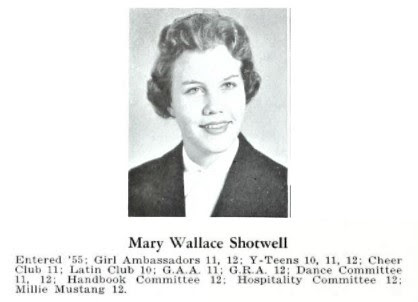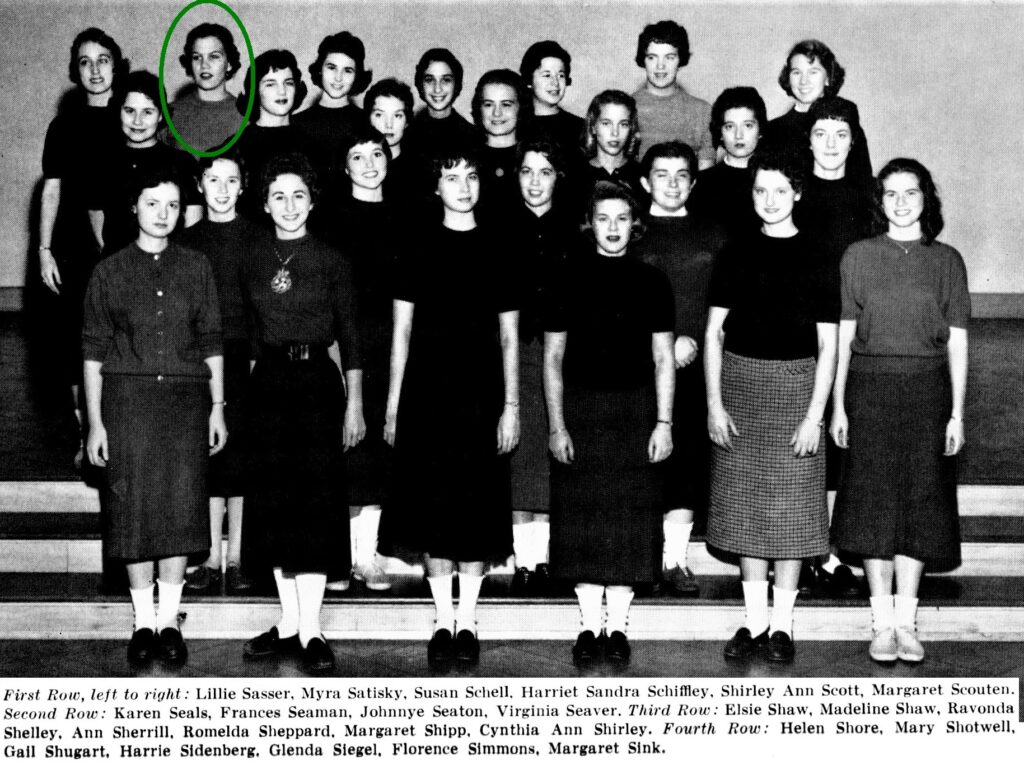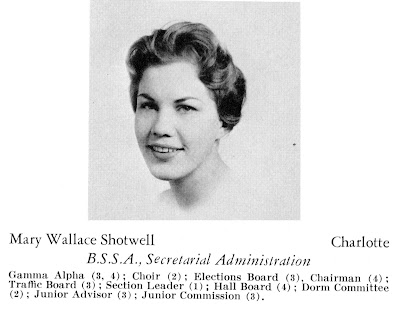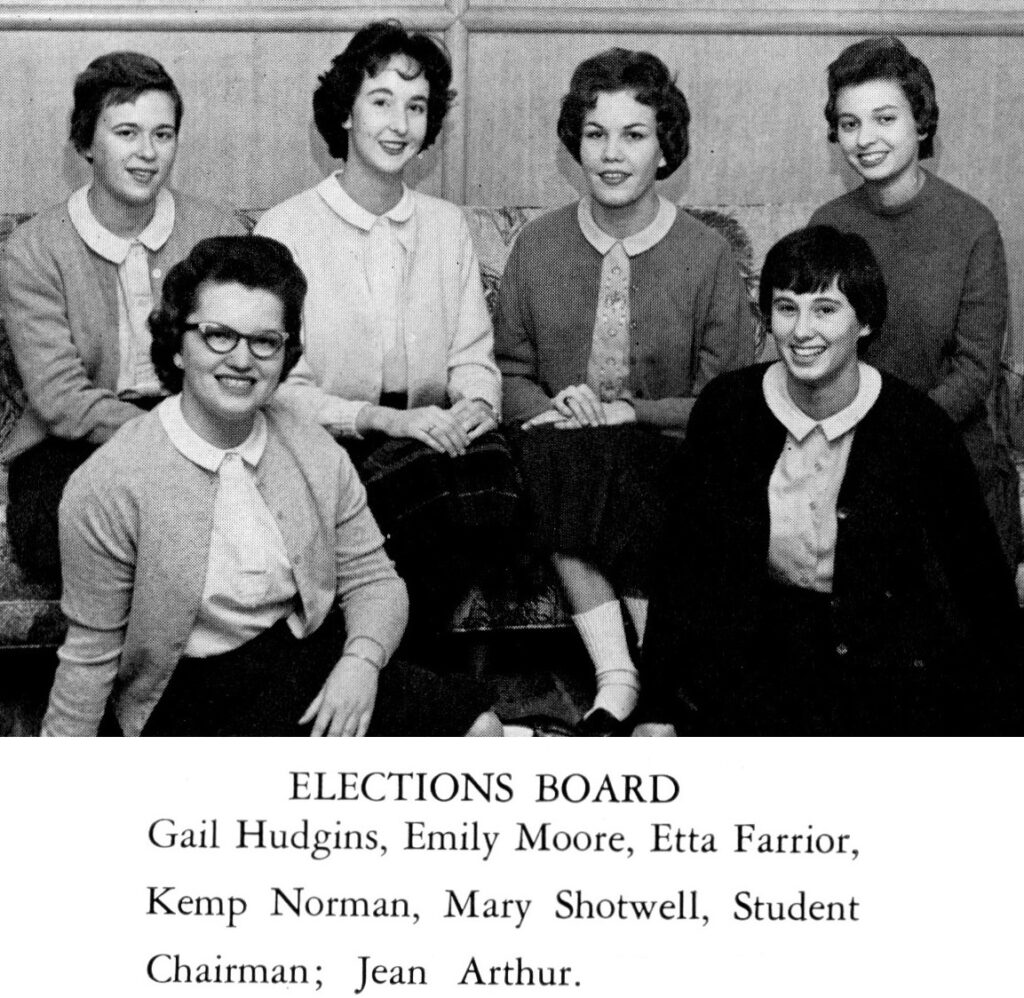
In the many years since UNC Greensboro opened its doors in 1892, our institution has been remembered and honored by the contributions and legacies of our alumni. The school has prepared an army of students to enter the world, carving their own path and contributing to future generations. However, one of our alumna is best known for the mystery of how she vanished, leaving behind an enigma that has bewildered family and friends and baffled law enforcement and true crime aficionados for over 50 years.
Mary Shotwell came to the North Carolina College for Women (Woman’s College), now UNC Greensboro, from her family home located at 117 Placid Place, Charlotte, NC. As its name suggests, it was a peaceful, suburban neighborhood with typical 1950s one-story, box-like brick houses. A graduate of Myers Park High School, she arrived as a college freshman for the 1958-1959 school year. Mary attended our school at a time of many changes: our enrollment had just exceeded 2500 students, the Woolworth Sit-Ins occurred during her sophomore year, and the second McIver Building (located where the current nursing building stands) and Moore-Strong Residence Hall opened during her time on campus. Mary’s “Class of 1962” colors were green and white, and the class jacket she would have worn with her other classmates was a hunter green blazer with three gold buttons, and with white embroidery on the breast pocket.

Mary was a tall, slim-framed, young woman, 5’6″ in height, weighing around 120lbs. She had hazel eyes and light brown hair. Mary was involved with student life on campus, singing in the college choir, serving as chairman of the Elections Board, and working in several other organizations and committees. The 1960s was a time of transformation in our country, and as a college for women, our students were interested in advancing the status of women. The motto of Mary’s class was “It’s not the gale but the set of the sail that determines the way we go,” emphasizing that this was a class of women who would determine their own future. Many of the yearbooks during Mary’s years on campus focused on the transitions of women’s roles in the United States, even titling the 1961 Pine Needles, “It’s a Woman’s World.” Women were entering the workforce in greater numbers, and Woman’s College provided its students with the training they needed to thrive. However, in many cases, women were still limited to socially acceptable careers for their gender. One of those professions was secretarial administration, which is the degree Mary chose to pursue. In 1962, when she graduated, undoubtedly, Mary felt she had a long, rewarding life ahead of her with no clue that she would become one of Georgia’s most infamous missing person cases three years later.

Mary graduated in Spring 1962, one of among 36 women getting their diploma from the secretarial administration program. With degree in hand, Mary, was hired as a secretary for the Citizens and Southern Bank in Atlanta, GA. According to the 1962-1963 Alumnae News, she lived at 1300 University Drive, moving in as a roommate with a group of other women. It would have been a bit of an adjustment for Mary to adapt to a solitary work life in a new, unknown city compared to the protected microcosm of Woman’s College. While at school, she would have been subject to many restrictions. A strict dress code was enforced, and women were allowed only to sunbath at designated spots on campus. Walking on campus after dark was restricted, with the exception of residential areas and College Avenue. If Mary wanted to go on a date with a man off campus, she would have had to get a permission form signed. She was entering a very different world in Atlanta. All this being said, Mary made friends quickly among her roommates and coworkers. It was not long before she started to date, which would be a very different process from the highly controlled formal dances and gatherings allowed by the College. After around two years, Mary met the man she would marry. On September 4th, 1965, she married her husband, Roy Little Jr. Shortly thereafter, on October 14th, 1965, at the age of 25, Mary went missing and was never seen nor heard from again.
On October 14th, Roy was out of town on a business trip, and Mary went to work at the C & S Bank, as usual. After work, she went grocery shopping at the Colonial Grocery Store at Lenox Square in Atlanta, then she went to the S & S Cafeteria to have dinner with a coworker, followed by shopping with that friend at Rich’s Department Store until 8 p.m. After shopping, she and her friend went their separate ways in the parking lot, Mary walked to her 1965 Mercury Comet, but she never made it home. The next day, after Mary did not report into work, her supervisor became worried. After conferring with the coworker with whom Mary had dinner, the manager went to search for her vehicle. Mary’s car was discovered in the Lenox Square parking lot. Found within the car were the groceries she purchased the night before and her undergarments (including one stocking that had been cut at the toe), most of which was neatly folded. Among the missing items were her purse, keys, outer clothing (an olive green dress), her raincoat, and jewelry, including her Class of 1962 Woman’s College ring she consistently wore. There were visible traces of blood throughout the car. These are the basic facts of Mary’s disappearance, which remains unsolved to this day.

Adding to the mystery, law enforcement found several tantalizing anomalies while conducting the investigation. There were two charges from October 15th on Mary’s credit card for gas stations in Charlotte, NC for the early morning hours of the 15th and Raleigh, NC, 12 hours later. The receipts appeared to have her signature, signed as Mrs. Roy Little Jr. Both gas station attendants recalled seeing a woman that night who appeared to have been bleeding and in the accompaniment of one or two men. The North Carolina license plate listed on the receipts turned out to have been reported stolen a few days earlier. Mary’s husband, Roy, kept a constant count of the mileage on the car, and it was noted that the Mercury Comet did not have enough miles on it since his last check to have traveled to and from North Carolina, but there was still 41 miles that were unexplained. When it was noticed that Mary went missing by her employer, her car was found back in the Lenox Square parking lot, but the car appeared to have been moved at some point, as the Lenox Square security kept a log of overnight parked cars and ticketed them, and Mary’s car was not ticketed through the entire night.
After interviewing coworkers at the bank, investigators uncovered that Mary had been receiving harassing phone calls at work, and roses had been sent to Mary by an unknown person. As the investigation continued, gossip about the C & S Bank added another layer to the case. There were reports of a prostitution ring being run out of the bank, and complaints of lesbian sexual harassment of employees was uncovered, leading detectives and researchers to speculate about possible connections to Mary’s disappearance, but there was never any substantive evidence, only rumors. Another woman who worked at C & S Bank after Mary went missing, Diane Shields, was murdered in 1967, and there are many shocking coincidences between the two women’s lives. An unusual quality of the case is that there are so many potential leads to follow, but none seem to lead to an answer of what happened to Mary. While this was a highly publicized disappearance during the 1960s, modern true crime fans have been enamored with Mary’s disappearance. A quick search for “Mary Shotwell Little” on the internet will produce dozens of results featuring stories from true crime websites, YouTube videos, podcasts, and Reddit threads. Speculation on the circumstances of Mary’s disappearance vary wildly, from the disappearance being staged by Mary to escape her marriage to some level of involvement with the Dixie mafia. The indulgence of such imaginative lines of thought is not surprising, as we do not know ultimately what happened to Mary, and the scientific testing available in criminal forensics today was not available when she went missing. Some of the original evidence and files are missing or have been destroyed since the case was opened, so the exact facts are difficult to discern. There is no DNA evidence existing that can be tested. Additionally, it is easy for the public to be infatuated by the potential scandals and gossip of Mary’s story, so many decades removed from the event.

By the time of Mary’s disappearance in 1965, our school had become co-educational and officially named the University of North Carolina at Greensboro. The university student population was still predominantly female, and the women of the Class of 1965 would have been freshmen when Mary graduated, so some students may have known Mary and would feel her disappearance on a personal level. The disappearance made the front page of the October 22nd, 1965 issue of the student newspaper, The Carolinian. Whether or not there were many people on campus who knew Mary in depth, as upperclassmen may not have mingled as much with lowerclassmen, it can be expected that such a story would have been noted by our women students. The university was preparing women to enter the workforce in the 1960s as professionals, moving away from their hometowns and families, to start careers and be independent. Young women might be prepared in terms of knowledge and skill sets, but the world was still a dangerous place to navigate alone, especially in large cities like Atlanta. Perhaps, one of the attractions of Mary’s story to this day is that such an incident could happen to any young, career woman, and many women can imagine themselves in Mary’s place
Most of Mary’s family and friends have passed away since her disappearance in 1965. She is mostly remembered in association with her disappearance case, which still haunts the people of Georgia. However, in 2012, during the Woman’s College Class of 1962 50th anniversary reunion, Mary was among the 44 women remembered in the Reunion Biography Book. Unlike the other alumna who were deceased, what happened to Mary still remains a mystery; only her lack of presence could be mourned by her classmates.
If you are interested in learning more about the Mary Shotwell Little’s case, see:
Depriest, Joe. “Mystery of Charlotte woman missing since 1965 leads former Atlanta police detective to Mount Holly.” The Charlotte Observer, October 20, 2014.
Lee, Natasha. “Exclusive: A possible crack in the cold cases of Mary Shotwell Little and Diane Shields.” CBS 46 (WGCL-TV), October 24, 2019.
“Mary Shotwell Little.” The Charley Project, last updated October 12, 2004.
Noll, Jessica. “5 Roses, 2 women: Did their lives collide, ending in murder?” 11 Alive (WXIA-TV), January 17, 2019.
Noll, Jessica. “5 Roses Podcast”: https://fiveroses.podbean.com/
By Stacey Krim